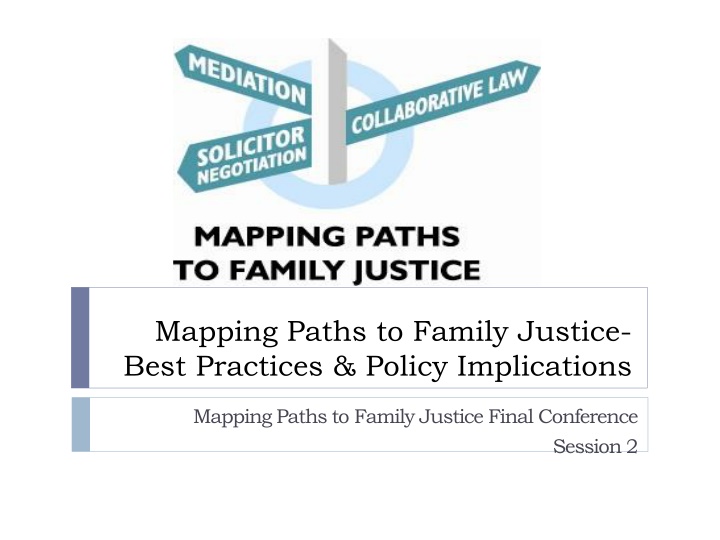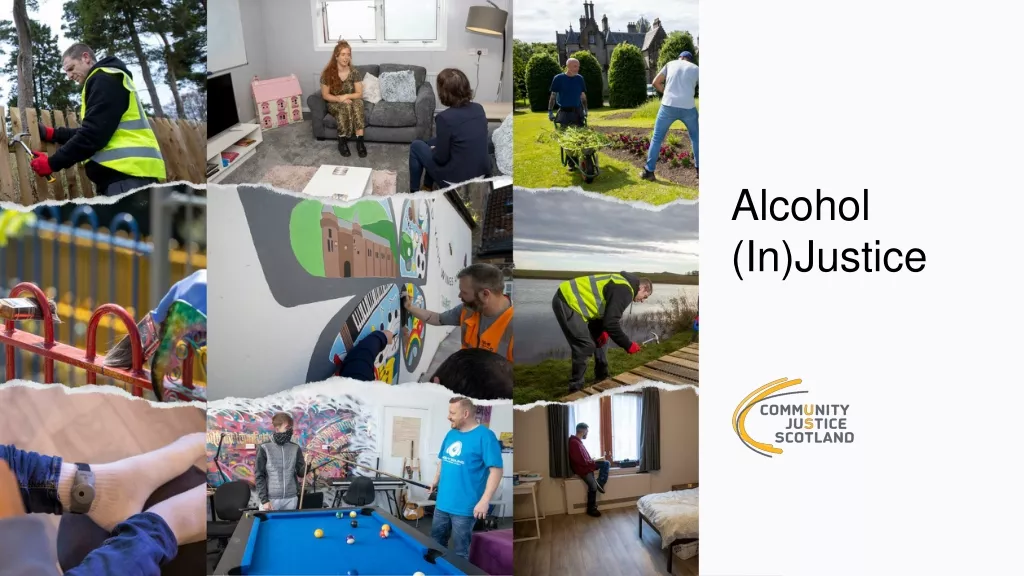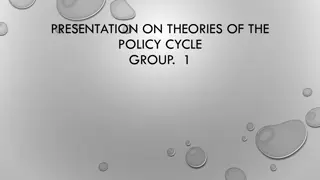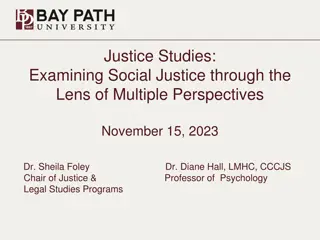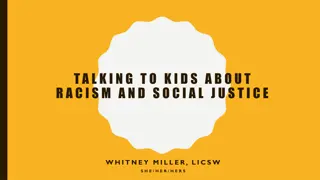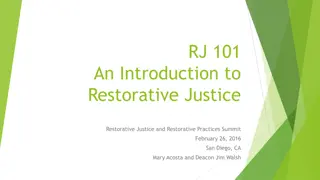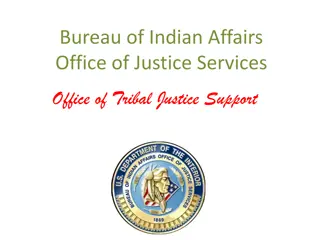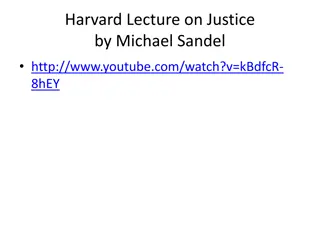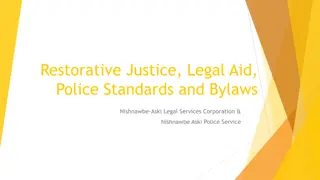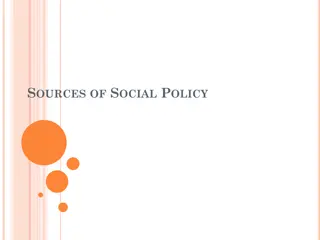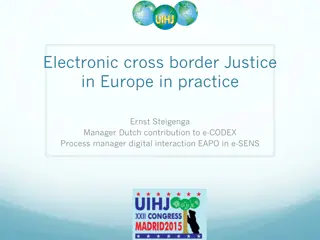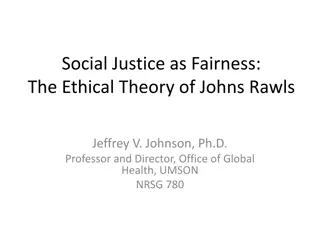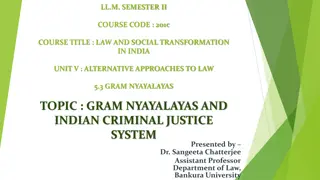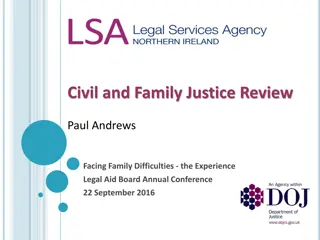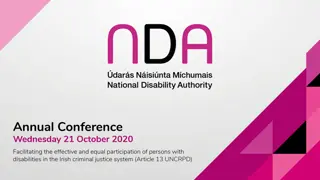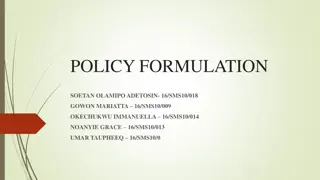Insights on Family Justice Best Practices & Policy Implications
Through a study on mapping paths to family justice, key insights were gathered. The conciliatory approach is dominant in settling cases, with practitioner quality playing a crucial role in higher conflict disputes. Emotional readiness is often a barrier, and the child's voice competes with adult rights. Parties need real choice in dispute resolution, supported by professionals, and court can be appropriate. Offering clear, neutral information is vital, as some clients face constrained choice due to costs and circumstances.
Uploaded on Sep 15, 2024 | 2 Views
Download Presentation

Please find below an Image/Link to download the presentation.
The content on the website is provided AS IS for your information and personal use only. It may not be sold, licensed, or shared on other websites without obtaining consent from the author.If you encounter any issues during the download, it is possible that the publisher has removed the file from their server.
You are allowed to download the files provided on this website for personal or commercial use, subject to the condition that they are used lawfully. All files are the property of their respective owners.
The content on the website is provided AS IS for your information and personal use only. It may not be sold, licensed, or shared on other websites without obtaining consent from the author.
E N D
Presentation Transcript
Mapping Paths to Family Justice- Best Practices & Policy Implications Mapping Paths to Family Justice Final Conference Session 2
Commonalities across process In all processes, we found Conciliatory approach is now dominant in all processes Lower conflict cases are usually easier to settle Quality of practitioner(s) is key to settling higher conflict disputes Lack of emotional readiness is often a barrier to settlement; high instances of depression were reported The Voice of the Child is a focus across the processes but is in strong competition with entrenched adult rights discourses Any process can be used to avoid settlement
Learning lessons- moving to best practice Parties need real choice where possible to effect appropriate dispute resolution and this should be positively (rather than negatively) offered to clients Support from other professionals during any FDR process is often needed and should be a joined up rather than a competitive process All Professional Associations have a key role to play in providing comprehensive training and high standards of professional conduct It is important to acknowledge that court is sometimes appropriate
Best Practices in Offering ADR Options to Separating Parties Mapping Paths to Family Justice Final Conference
Enabling Informed and Appropriate Choice Clients should receive clear, accurate, neutral information and advice on available FDRs and their strengths and disadvantages, tailored to their situation, and with sufficient opportunity to discuss concerns and reservations. They [mediation service] were very good they checked sort of every step of the way that we were happy with it, and what the limitations were, just to make sure that we had no false expectations, and very much emphasised that it was to help us sort things out (Norah, who mediated) .
Working with Constrained Choice In reality many clients are constrained by cost, and by the other party s wishes. I didn t feel I had a choice, it was either mediation or I felt it was my only real choice to, kind of, get things sorted, especially to do with my child. Because I basically got told in terms of solicitor s time, it was too expensive; there wasn t enough legal aid to do it. (Sonia) The perception of being forced into an ADR without choice often contributed to this breaking down: So did you feel you had any choice in which form of dispute resolution you used? Well, she started the action, I had to respond to it, so I did. (Victor, who deliberately dragged out Solicitor Negotiation by being as slow and unhelpful as possible) .
Practitioner knowledge of the FDR options Practitioner knowledge and experience of what different FDRs have to offer is a key factor in this context. Practitioners who have undergone training in each process are better placed to explain the full range of options than those who have not. More training in the various FDR options e.g. the availability of DVDs of each process would go some way to filling this gap. .
Emotional Readiness in hearing what is offered. Clients emotional state needs to be factored into information delivery about options. I don t want to do [solicitor] a disservice. He could have explained it incredibly well, but at that point in time.. it s really hard to know what the hell s going on. (Glenys) I didn t know who to go to, what to do, and then he started talking about the collaborative thing. At the time I felt like I was being completely bamboozled because he was saying, This is what we ve got to do, you ve got to do this, you ve got to do that. (Pauline) Parties were particularly unclear about whether they had had or read a Code of Practice, and what this information consisted of. .
Emotional Readiness and appropriate options. Good practitioners recognise when clients are not emotionally capable of absorbing information and making effective choices and slow the pace and/or refer clients for professional assistance accordingly. Did she speak to you about the relationship and any emotional issues that were going on as well? Yes, she did. We talked about that. That was when she explained the processes. That s why I said I didn t want to go for mediation at that point because I just didn t feel that I could do it, I suppose. I didn t really feel strong enough to do it. (Tracy, who used Collaborative Law) .
Susceptibility to practitioner influences While many practitioner did describe a range of options, many parties were susceptible to practitioner preference, and followed their practitioner s enthusiasm for a particular FDR: She was very pro-mediation. So she kind of described it in favourable terms. Just that you d be able to get in a room together and work with a professional third party who would help you to talk about the issues and then you can come to an agreement (Charlotte) .
Time to research and consider options Clients should be given sufficient time to inform themselves and prepare for the FDR process. As soon as [lawyer] had suggested the collaborative divorce process he sent me away with literature on the different possibilities and then I did my own research online of what that meant." (Marcus, Collaborative Law). .
Effective screening Effective screening for client and case suitability is needed in all processes, combined with appropriate responses to the situation. As well as screening for risk in domestic abuse and child abuse cases, practitioners should be alert to other factors which affect FDR suitability, including mental health issues; Did you feel that your lawyer took into account your emotional state during the process? Yeah. That was the main thing that he did do. He knew I had mental health problems and he made sure I understood everything crystal clear (Richard) Also including power imbalances and the potential strategic use of Mediation or Collaborative Law by a dominant or controlling partner; I would have hated [Collaborative Law]. I was married to a lawyer, you see. (Eve) .
Summary of Best Practice in giving options to clients Constrained choice: helping clients make choices which fit their needs pragmatically. Emotional readiness: giving time to talk and think through options, helping them choose an emotionally suitable process. Susceptibility to practitioner influences. Being aware of their influence here. Offering neutral intake sessions.
Selling Family Dispute Resolution Positively Mapping Paths to Family Justice Final Conference
Key Message There are sufficient positive reasons for referring clients to FDR to make negative stereotyping of court outcomes unnecessary.
Undermining of the court process Rather than promoting FDR on its own merits practitioners undermine the court by emphasising: Costs Delay Loss of control over outcome Uncertainty of outcome
Overstating judicial unpredictability [T]he court... is not a great system, it's very slow and the outcomes are pretty unpredictable... [O]ver financial issues I think that the court does more or less what is sort of sensible you know... and I think over kids it does something very different, and I think particularly with little babies or little ones it is even more unpredictable because the judges are not really trained in this stuff and don't really know what they are doing. [Solicitor-client interview 201].
Overstating judicial discretion "I have certain little visuals, sort of analogies that I use, painting pictures that I hope help[s] [clients] to remember things. Twelve different District Judges in a room with the same set of facts come out with thirteen different decisions and things like that, that just help them." (Jane Davison; mediator, former solicitor).
Overstating judicial discretion creates uncertainty "I knew that if I took it to court I could be faced with somebody taking a very different view. It seemed to me that I had no idea what to expect I didn t really want it to go to court because a) it would be hugely expensive, b) because it would be extremely stressful for everybody concerned and I was completely in the dark as to what the likely outcome would be." (Simon: settled financial case in mediation following solicitor negotiations).
Overstating judicial discretion creates pressure The undermining of court proceedings: Puts parties under undue pressure to settle on terms which may be unfair. Creates additional stress and anxiety if they do have to go to court.
Overstating judicial discretion undermines Overstating judicial discretion/uncertainty of court outcomes: Restricts practitioners ability to bring the shadow of the law to bear in FDR Undermines respect for the law generally Provides ammunition to the view of family law as arbitrary and biased Fails to recognise that court proceedings are the first and most appropriate resort in certain categories of cases
The positives of court proceedings "If it doesn t seem that they are very close and it seems that there is a lot to play for for both sides, then I will issue straight away and it s like right, court timetable s engaged, we can try and have a round table meeting prior to the first appointment So it s in [the other party's] interest to provide us with as much disclosure as [they] can and then we can try and strike a deal... So my tendency will be to try to issue early so that there is an end in sight and there are milestones along the way. (Francesca Lamont, solicitor).
Mutual respect Very often FDR is the best option but sometimes court proceedings are necessary. An attitude of mutual respect between FDR and family courts would be better practice
Positives of mediation Mediation offers: The potential for speedy, cost effective solutions The retention of decision-making by the parties Longer-term support for the co-parenting relationship Scope for creative solutions: What we loved about mediation, you know, I mean they came up with this solution that neither of us had seen or considered. (Jasper)
Positives of solicitor negotiation Solicitor negotiation offers: Legal advice and expertise from an ally A 'buffer' particularly to vulnerable parties through arms- length negotiation: My solicitor was good, because she would sit me down and say, Right, this is what happens next. This is what your options are. [She] did empower me, really I felt it was a bit like a boxing ring and I was in- I was really flat out when I first saw her. [By the end] I d got up again. (Stella)
Emphasise the positives Key Message: There are enough positive reasons for parties to engage in FDR These should be the focus of practitioners representations and marketing campaigns, rather than scare stories about going to court.
Mapping Paths to Family Justice- Voice of the Child Mapping Paths to Family Justice Final Conference
Voice of the Child Among our practitioner sample, focusing on the child in children or all issues cases was confirmed as best practice in all FDR processes. For mediation, it was seen as a fundamental tenet linked with improving communication between the parties as parents for the sake of the children. Party experience overall confirmed that this was attempted by most practitioners to put children at the centre of negotiations.: Did she get you both focused on your child s wellbeing? Yeah, she did. It were obvious that her main goal was to- I mean, she d never met my daughter, but her main goal were to get something sorted between pair of us for her. (Kathy, Mediation) And did you feel that the lawyer focused on the welfare of your children and was looking out for them? Yeah. Yeah, that s what the main concern was. That s where his main argument was and everything. (Richard, Solicitor Negotiation) The increasing number of hybrid practitioners, qualified in more than one process, has arguably helped to ensure that child focus has become part of lawyer-led processes.
Good practice around Voice of the Child We found that good practice, where mediators were skilled at reframing questions around children, was appreciated by parties One of my husband s objectives was to spend as much time with the children as possible and so the mediator said, Well, why don t we phrase it as to be able to build meaningful relationships with the children? (Tracy, Mediation) Examples of this were identified in recorded sessions too: The reality is, as you have said, you have got kids and they are at the heart of the solution. (Solicitor-Client Interview 203) Because you have both accepted that you do want [child] to have a relationship with his dad, so how can we reintroduce contact in a way that would be sensitive for [child]? (Mediation 209(1))
Voice of the Child In some cases, after prolonged dispute, consulting the children had helped to resolve the issue. Sheila s ex-husband proposed in Collaborative Law an arrangement whereby the children would spend more time with him, which Sheila resisted because she did not think it would be in the children s best interests at that particular time. This was one of the reasons the collaborative process broke down, after which: I actually spoke to the kids... and I said, Look, part of the reason things were difficult was because we were about to make these new arrangements. What do you think? And they said, Fine, we ll try it . (Sheila) It would appear that consulting children may be an effective mechanism for dealing with some difficult cases, particularly where parties have fixed and incompatible conceptions of child welfare.
Voice of the Child and child-inclusive Mediation Only Mediation offers a child-inclusive (as opposed to child-focused ) process. Although a high number of the mediators in our practitioner sample had trained to undertake child- inclusive mediation, we found this to be very rare in practice A typical practitioner response was, It is done very occasionally in this practice, say one or twice a year. [T]he only difficulty with it is that, generally speaking, it is the more difficult cases that you would involve direct child consultation. (Gordon Russell)
Voice of the Child and child-inclusive Mediation Some practitioners felt it could - help parents view matters from their children's perspective be useful for older children Practitioner reasons given as to why it is so rare include, Neither or only one parent would consent The child was not willing to participate It places pressure on the child Cost Some practitioners indicated a lack of confidence around undertaking the child-inclusive process: One of the mediators who work for me has done the course and erm we have done it once I think but neither she nor I are actually particularly keen on it as a principle and so I don't see children so we don't. We can offer it in very unusual circumstances but it is very rare. (Melanie Illingworth)
Voice of the Child and child-inclusive Mediation Within our party sample, a few people had considered and rejected child-inclusive mediation, with concerns about the possible emotional impact on the children: I think [mediator] said, Perhaps I could invite [daughter] along to get her involved. But she didn t want to go. I was trying to make it the least stressful for her as possible. So yeah, that wasn t really good . (Lynn) One father had experienced child inclusive mediation, and still had reservations, although it had enabled them to agree on one issue around choice of secondary school: I think mediation has to be child focused. Rather than child inclusive. ... I think there s better ways of focusing on the child than actually bringing them to mediation. I think it puts them in a very difficult position. (Ernest)
Child-Inclusive Mediation Australian research However, despite these misgivings by parents and practitioners around including children in the mediation process in our data, a recent Australian study comparing child focused and child inclusive mediation came to positive conclusions: The best predictor of resolution overall was not the parents mediation group, but their levels of acrimony, conflict, and cooperation. Nonetheless, parents perceived that there were benefits from the involvement of children in the process other than achieving better outcomes in terms of dispute resolution, and the experience of having the children seen by a child consultant was generally positive. (Bell et al, 2013) However, the same study found that child-inclusive mediation could also lead to disappointment when raised expectations were not fulfilled.
Child- Inclusive Mediation Australian research Another earlier Australian study reported by Moloney and McIntosh (2008) pointed out, Child- inclusive practice, more formally fulfils the aspirations of the United Nations Convention on the Rights of the Child (and statements from similar bodies) that children should be consulted when decisions about their welfare are being made. They support child-inclusive practice (as defined in Moloney & McIntosh) which allows for consultation without placing the burden of decision making on the child. The Family Justice Young People s Board in England and Wales feel strongly children s voices should be heard, should Mediation be an exception?
FJYPB Charter Whilst focusing on court proceedings, their charter recommends - 1. Children and young people should be at the centre of all proceedings. The child or young person should feel that their needs, wishes and feelings have been considered in the court process. Each decision should be assessed on its impact on the child 3. Every child should be respected and treated as an individual 5. Children and young people should be given the opportunity to meet and communicate with the professionals involved with their case including Cafcass workers, social workers, judiciary and legal representatives... 7. Every child and young person should have the opportunity of giving feedback through email, text, telephone or written form. 8. Children and young people should be involved in all developments in family justice. Inspection by young people of the family justice services. Involvement in training of all professionals in family justice.
Support & Collaboration in FDR Providing Joined Up Services
Tailoring the process for the client Family lawyers with an interest in ADR also need to be creative; it s a creative process. (Matthew King) Part collaborative / part mediation, with counselling and/or financial input Bespoke solutions fitting process to party Engage specialist support as appropriate
Holistic approaches to clients needs Addressing the issues holistically Multi-disciplinary approach to address clients needs fully More cost-effective for the client: I don't need to do that. I can bring in other people who can do it better. (David Leighton).
Tailoring services for all clients? For the benefit of private clients to date What can be done with legally aided mediation? Free referrals to DV support services / counsellors Claiming the costs of pension valuations as disbursements.
Well-established linkages Financial advice in mediation/collaborative law IFAs, pension advisers, pension valuation Legal advice during/after mediation Need for advice to assist in the process Advising on agreement/securing consent orders in financial cases Referral prior to commencing mediation?
Connections less often mentioned Counselling/therapeutic DV support Parenting education Connections referred to often stemmed from a mediator s professional experience prior to mediation training. Solicitors who do not practice mediation or collaborative law are least likely to have well established networks.
Co-operative relationships Between mediators, lawyers, financial advisers, child consultants... I am building a multi-disciplinary model which involves accountant neutrals coming in getting engaged in agreements, financial planner neutrals, valuer neutrals and so on (Peter Young)
Key Message: A bespoke service, tailored to individual cases rather than an off-the-peg product best meets the needs of clients. Such a service requires the establishment of joined- up, cooperative relationships between professionals.
Policy Implications Mapping Paths to Family Justice Final Conference
Policy Goals To promote conciliatory approaches to the resolution of post-separation family disputes To enable and support an efficient and cost-effective system of out-of-court dispute resolution, responsive to the range of clients needs and circumstances To minimise public expenditure on family law disputes To promote and maximise the well-being of children affected by parental separation To enable swift recourse to court proceedings where these are unavoidable
No-Fault Divorce JP: So what we want is we want to start the divorce ... as soon as possible so that we can get to the stage where the court can make a financial order as soon as possible. ... RB: The disadvantage of doing that is that you don't have the ability to just have a divorce on the basis of separation which is a sort of what's called a no fault way of separating. Somebody needs to do the divorce and they need to be blaming the other. However artificial that is, that is the only of doing it. JP: So somebody has to decide who is going to be the one who is going to take... RB: Who is going to do the blaming. JP: Who is going to do the blaming and who is going to take the blame. ... RB: ... we are in a situation where somebody has got to do it to be able to get that next stage and ... we need to do it now, because you know, we have got to get those documents drafted and in front of the court to get the finances for the next stage. JP: So there are two options, there is a divorce on unreasonable behaviour or there is divorce on adultery. ...
JP: ... So adultery, that has to be admitted but you don't really need to say very much, whereas with behaviour you do have to have usually, and I would usually say about half a dozen mild allegations, so mild things that you would have to say about the other. But the one who is receiving the divorce petition can mark on the court form that you don't accept any of the allegations, so you can actually deny it all and the behaviour divorce can go through. But on the adultery divorce you have got to admit it as otherwise that won't go through. It s a question of what you feel more comfortable with. GQ: Well unreasonable behaviour just sounds pretty vile around sort of children stuff to me. JP: It doesn t have to, it really doesn t have to. GQ: That would be my only concern. I mean I know it s all just make-believe but... JP: We could talk about what should be in it. GQ: No, I wouldn t want it. Like I say, I wouldn t want something to happen and it could come back at any point, so to sort of say that he was unreasonable around the children or something. RB: But I mean if you want to do it, it s cost effective for you and hassle effective for you and we can sit around now and draft it up if that's easier. GQ: Yeah, it might help things as otherwise... RB: But one of the problems is inevitably it causes tension because neither of you want to be saying this. It just has to happen to be able to get the divorce.
SQ: Is it just easier to do it on adultery, because then you havent got to come up with reasons? GQ: I think so, personally. I would, yeah. JP: So who is going to start the divorce, who is going to be the person who applies? GQ: I will do it. ... RB: Ok, Gary will be starting, ok. JP: And so that's going to be on the basis of your adultery Sandra, which you will have to admit. SQ: Ok. JP: Just thinking through what the court will need for that. The court may need a date. RB: So various dates, various locations. JP: We can do it; we will do it that way. ... RB: Well that's much easier because if we are doing it on that basis we don't need to talk about it. (Collaborative Law 204(1))
Appropriate Dispute Resolution Facilitate and support all forms of FDR Recognise different options may be more or less suitable for different parties Mediation Solicitor Negotiations Collaborative Law Encourage and support Resolution and the Law Society to promote non-adversarial practice Support and encourage collaborative work between lawyers and mediators referrals in both directions
